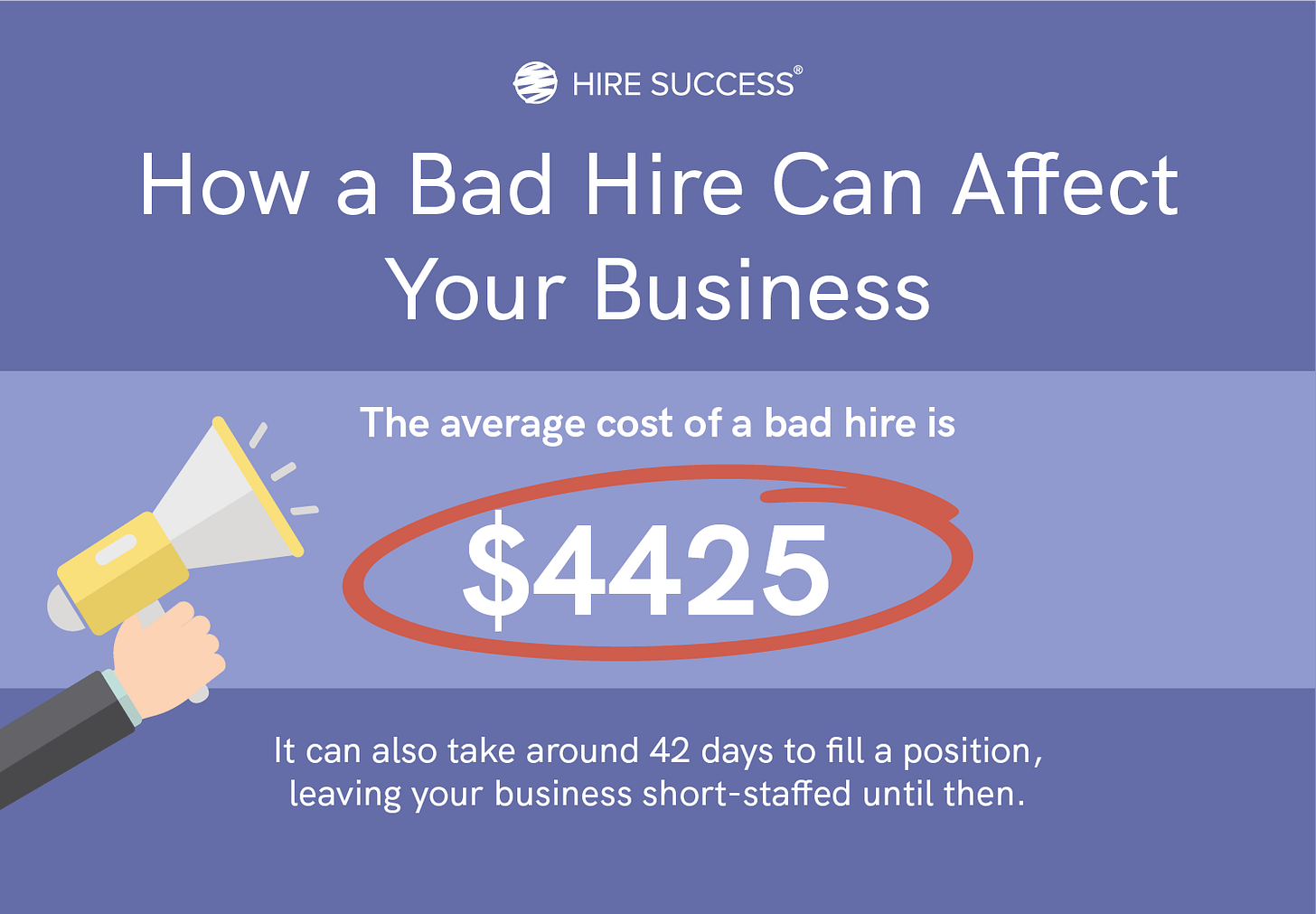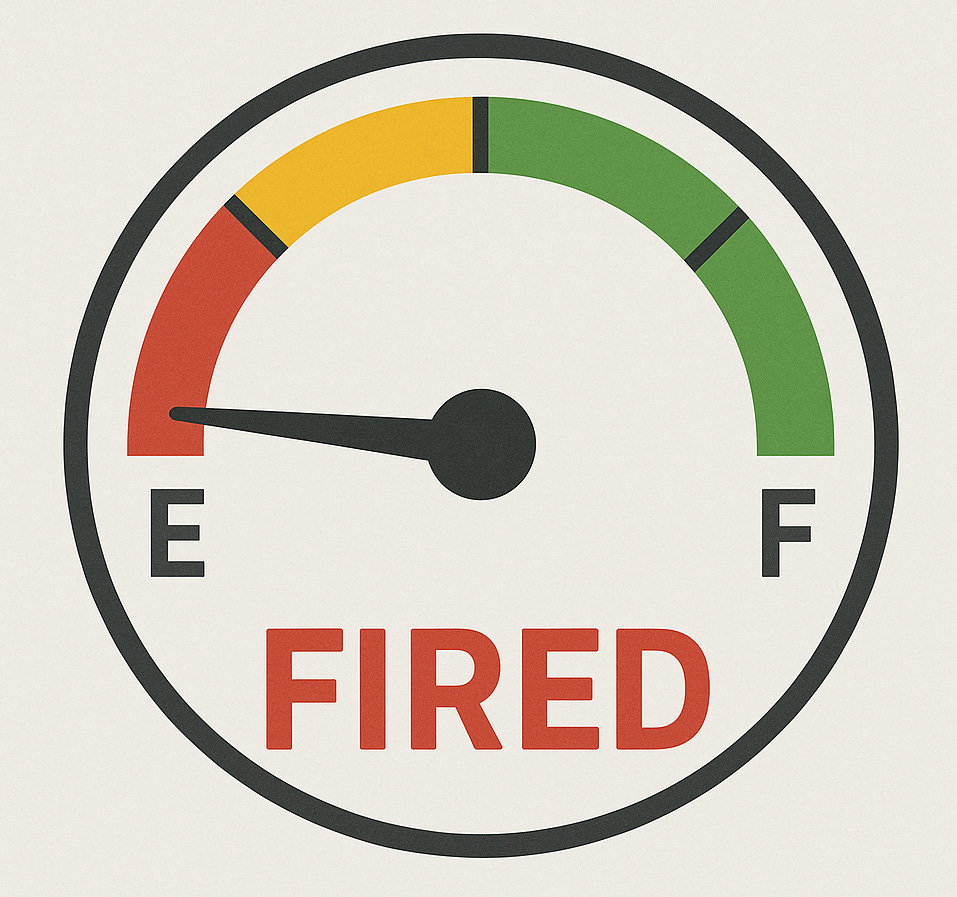The Toughest Decision: Firing Without Destroying Your Team
Founder OS: A deep dive on the psychology, timing, and playbook for making the toughest leadership decision with clarity and conviction.
Firing someone will shake you. No matter how seasoned you are, it never feels good. But it’s one of the most important calls you’ll make as a founder, and one of the easiest to get wrong.
When you do it right, you protect the culture you’re trying to build. You send a clear signal about what matters. You make space for someone who’s ready to carry the weight.
But done poorly, or delayed too long, it chips away at trust. It frustrates your best people. It slows everything down.
And indeed, most founders delay. They hope it’ll get better. They avoid the discomfort. Or they try to convince themselves that loyalty, potential, or time will fix it. Meanwhile, everyone else on the team sees what’s going on, and they start wondering why you won’t act.
The worst part is that nobody teaches you how to do it right. And that’s exactly what this guide will do.
We’ll talk through the psychology behind hesitation, the moments that matter, and the process of letting someone go in a way that’s clear, kind, and aligned with the kind of company you’re trying to build.
Because the hardest calls are where your leadership really shows up.
Table of Contents
1. Why Founders Wait Too Long
2. When to Coach, When to Reassign, and When to Fire
3. The Signs You Can’t Ignore
4. How to Fire Someone Without Losing Yourself
5. What the Team Needs to Hear After
6. The Founder’s Mindset: Courageous, Compassionate, Clear
1. Why Founders Wait Too Long
Every founder has someone they kept too long. You know it in your gut; weeks, sometimes months before you’ll say it out loud. But you hang on. You justify. You rationalize. You wait.
Sometimes it starts with gratitude. “They were there at the beginning. They took a chance on us.” That loyalty runs deep. You remember the scrappy early days, the late nights, the trust. And it feels wrong, almost cruel, to turn around and say, “This isn’t working anymore.” But that guilt loop keeps you stuck. And being stuck is dangerous, especially for startups.
Other times, it’s fear. Fear of being the kind of leader people whisper about. Fear that you’ll be seen as heartless, impulsive, or disloyal. So you sugarcoat the truth, drag out the feedback cycle, and hope things magically improve. You don’t want to look like the villain. But silence can make you look worse. Because while you hesitate, the team watches.
Founders are optimists. They want to believe people will grow into the role. They hope that with one more quarter, better systems, more clarity, they’ll figure it out. But hope wrapped in sunk cost thinking is nothing like true leadership. It’s avoidance.
And that delay has a price: missed goals, slowed momentum, and top performers quietly slipping out the door because they’re tired of covering for someone who shouldn’t be there.
The truth is that your best people will notice. They know when someone’s not pulling their weight. And the moment they see you protecting mediocrity, they start losing faith in your judgment, even if they never say it. That erosion is hard to repair.
Sometimes your gut realizes before the data reveals it. You can’t always point to a specific metric or clear failure. But something feels off. The energy’s not there. The trust is fraying. The edge is gone. And even yet, you second-guess yourself. You wait for a “justifiable” reason, something objective, something clean.
But leadership isn’t about waiting for perfect clarity. It’s about acting when you see the slope, not just when you’ve hit the cliff.
If you’re thinking about giving someone “one more quarter,” ask yourself honestly: is that a performance strategy or just a way to delay the hard conversation?
Most of the time, you already know the answer.
2. When to Coach, When to Reassign, and When to Fire
Some decisions are clear. Others are murky. This is one of the murky ones.
As a founder CEO, you’re not just evaluating output. You’re constantly weighing loyalty, potential, timing, and the kind of company you’re trying to build. But the longer you hesitate, the more the situation calcifies, until you either lose your window to act or lose your team’s trust for not acting.
Here’s how to make the call when you’re stuck in the gray.
A Good Person in the Wrong Role
This is someone who works hard, shares your values, and brings real energy, but they’re misplaced. Maybe you hired them for growth marketing, and they’re clearly more of a product thinker. Maybe they were your first customer success hire, but your support needs have now outpaced their skills.
These are not people to fire. They’re people to shift. Great companies are built by spotting potential, not just performance. If they have the attitude, the hunger, and the cultural alignment, consider redesigning the role or carving a new lane where they can thrive often uses the same principles that help non-technical founders hire with confidence.
But don’t leave them in the wrong seat while you’re figuring it out. That’s how good people burn out.

A Loyal Early Hire Who Can’t Scale
This one hurts the most. They were there in the garage. They did everything before job descriptions existed. You trusted them when no one else even knew your name. And now… they’re underwater.
The company has grown and expectations have changed. Their ability to lead a function, manage complexity, or make strategic calls hasn’t kept up. But they’re still trying, still showing up, still loyal. So you keep hoping they’ll rise to the occasion. You buy them time. You hire coaches. You adjust the org chart to fit them in.
At some point, you have to face the truth: you need someone above them, or to outright replace them. Sometimes that means a respectful, clear demotion with dignity. Other times, they’ll choose to walk when you bring in someone senior. Either way, don’t let misplaced loyalty override what the business needs.
It’s not betrayal to change someone’s role. That’s what leadership is all about. Especially if it’s done with respect and full transparency.
A Misalignment of Values, Drive, or Accountability
This is the hardest to admit, and the easiest to justify away. But once you see it, you can’t unsee it.
We’re talking about the exec who talks a good game but blames others when things go wrong. The team lead who consistently avoids feedback. The product manager who’s smart but quietly undermines decisions they don’t agree with. What you’re seeing isn’t a lack of capability, but a lack of alignment on ownership, pace, values, and accountability.
And the remedy here is simple: fire quickly. No redesign. No waiting. Because every extra week you keep them sends a message to the team that alignment doesn’t matter.
The Role of Stage
In the early days, you’re hiring athletes; people who say yes to everything and figure it out as they go. You tolerate messiness. You lean on potential.
Post–Product-Market Fit, things change. That’s when you need operators. Specialists. People who’ve seen scale before. What was once “good enough” becomes the bare minimum.
So your tolerance for fit mismatch needs to narrow. Your job becomes less about giving people chances and more about building an environment where the right people can win fast. And if someone isn’t aligned, it’s on you to make the call early, while the cost is still containable.
Protecting the Mission, Not Just the Person
It’s easy to tell yourself that keeping someone on is “giving them a chance.” But more often, it’s giving yourself an excuse.
Reassign when there's alignment but a role mismatch. Demote with dignity when someone loyal can’t keep up with scale. But fire, firmly and fairly, when trust or values are off.
This is not about protecting feelings. You’re protecting the mission.
3. The Signs You Can’t Ignore
It rarely happens all at once. That’s what makes it so hard to spot.
One month, they’re skipping a few meetings. The next, they’re showing up late, cameras off, eyes glazed over. You tell yourself they’re tired. Burnt out. Maybe they just need a reset.
But then the friction starts creeping in.
They begin objecting to everything in your one-on-ones, not to improve things, but to slow them down. They question priorities but never offer alternatives. They hedge, circle, stall. Updates get vaguer. Wins get smaller. And soon, they’re spending more time explaining why something didn’t happen than actually trying to make it happen.
The energy is gone. The learning has stopped. You start to notice that they’re more focused on how they look than on what they do. That’s when the politics start: aligning sideways, nudging blame, being careful with words but not with outcomes.
And still, you wait.
Because it’s not a fireable offense. Yet. They’re not doing anything obviously wrong. Just… less right. So you rationalize. You focus on the few things that still work. You give it more time.
But what you don’t realize is that the team already knows.
They’ve seen the dip in effort. They’ve felt the drag. They’re covering for the gaps. They’re watching you, wondering if you’ll say what everyone sees.
As a founder, you’re busy. You're in a thousand meetings, juggling a dozen crises. The rot sets in slowly, and by the time it reaches you, it’s already spreading. And once trust is broken, once you stop believing someone will do what they say, when they say, they can’t lead anymore. Even if they stay on paper, they’re gone in spirit.
This isn’t about perfection. Everyone stumbles. Everyone has bad weeks. But there’s a difference between someone who's off-track and someone who’s no longer on the journey.
The real sign is simple: they’ve stopped pulling the company forward. And now, they’re pulling it back.
That’s when you know.
4. How to Fire Someone Without Losing Yourself
You’ll feel it before you say it. The moment when you know it’s time.
It may hit you during a one-on-one, in the silence after another missed deliverable, or in that gut-level realization: They’re not going to grow with us from here. The moment you know, everything else becomes a question of when and how.
Now the real work begins.
Before the Conversation: Get Clear, Stay Grounded
The worst mistake you can make is walking into the conversation emotionally unprepared or logistically vague. You need clarity above all. And they do too.
Start by writing it down: the key reasons, the outcomes that weren’t met, the specific points where alignment broke. This isn’t for debate. It’s for you, so you can steady your voice. Make sure you're not reacting from frustration or ego, but from facts.
Don’t wait until you’re angry. Don’t bottle it up until it spills out sideways. By the time you’re delivering the news, you should already be calm. Certain. Not cold, but clear.
And if you’re the founder or the person they report to, you must do it yourself. Delegating the hardest conversation to HR or a layer below sends the worst possible message, to them and to the rest of your team.
If someone gave their time to your company, they deserve to hear directly from the person who made the call.
The Conversation: Be Direct, Be Human
Set the meeting, and don’t bury the lede.
When they walk in, don’t talk about how hard this is for you. Don’t circle. Don’t stall. Say it plainly:
“This isn’t working out. This will be your last week with us.”
Let the words land. Let silence do its job.
And then explain why. But do it briefly. Use specific examples tied to outcomes like missed targets, repeated feedback, or lack of follow-through. Not character flaws. Not general vibes. Just clean, clear gaps that were discussed and didn’t improve.
What you must NOT do:
Don’t blame others. Own the decision.
Don’t say “we have to let you go.” It’s passive and deflective.
Don’t sugarcoat it as a mutual parting if it’s not.
Don’t gossip, pre-justify, or try to soften the moment with false praise.
You’re not here to make them feel good. You’re here to respect them enough to tell the truth, with compassion.
After the Conversation: Protect Their Dignity
How a person leaves the team matters just as much as why they leave. Most founders forget this.
Give them a narrative they can walk out with. If they want to frame it as a resignation, and you trust they’ll use it responsibly, let them. Offer to support that version. It’s not about saving face, it’s about preserving their ability to move forward.
If you can, help them land somewhere else. A reference, an intro, a warm handoff to someone in your network. These gestures go further than you think. They show your team that you care about people, even when you have to let them go.
Keep the goodbye low-drama. No spectacle. No rushed box-packing in front of everyone. Offer them time and space, or even a quiet exit if they prefer it.
And when you talk about it internally, do it with integrity.
“This was a difficult decision. We’re grateful for what they contributed. But at this stage, we need a different kind of fit.”
That’s enough.
No backstory. No judgment. Just clarity.
The Real Act of Leadership
Firing someone isn’t punishment. It’s not personal. And most importantly, it’s not weakness.
It’s choosing the mission over comfort. The team over ambiguity. It’s being the kind of leader who does the hard thing the right way, even when your hands are shaking.
You don’t need to be cold to be clear. You don’t need to be ruthless to be resolute.
You just need to show up fully, speak the truth, and leave the door open for respect on the other side.
That’s how you fire someone without losing yourself.
5. What the Team Needs to Hear After
The meeting ends. The person walks out. And for a moment, everything feels still.
That’s when many founders make the next big mistake. The mistake of saying nothing.
Maybe it’s out of discomfort. Maybe it’s an attempt to “protect privacy.” Maybe it’s because they’re still processing it themselves. But silence isn’t always neutral. It leaves a vacuum. And in startups, vacuums don’t stay empty. They get filled with speculation.
Your team doesn’t need the details. But they do need closure.
They need to hear, in your own words, that there was a process. That the decision was considered. That you acted for the right reasons. And above all, they need to see that you hold people accountable, and do it with fairness and respect.
Speak Without Oversharing
You don’t owe anyone a post-mortem. But you do owe them clarity. A simple and honest statement will do the job.
“We’ve decided to part ways with [Name]. It was a tough call, but ultimately, it came down to alignment with what we need at this stage.”
No blame. No drama. No bullet list of their flaws. Just a steady explanation that reinforces your standards and your care.
Kill Gossip Before It Spreads
Left unaddressed, a firing becomes company folklore. Whispers fill the hallways (or Slack channels), especially if the person was well-liked or in a visible role.
Gossip corrodes trust faster than underperformance ever did. If your team senses that things are being hidden, or worse, that someone was mistreated, they’ll start questioning what else might be lurking under the surface.
That’s when you nee to set the tone immediately:
“Out of respect for [Name], we’re not going to speculate. What matters is how we move forward and stay aligned with the culture we’re building.”
And if you hear gossip, shut it down. Kindly, directly, consistently.
Communicate Standards Without Fear
Founders sometimes worry that talking about a firing will make the team anxious. The truth is, clarity calms people down. Ambiguity is what breeds fear.
Let the team know what you truly value: ownership, learning, follow-through, alignment. Remind them that great work is recognized here, and misalignment isn’t ignored.
Done right, the message you’re sending is: we care enough to keep this place excellent and up to a standard.”
Done wrong, the rest of the team will think: “I could be next.”
It’s a “make or break” moment.
Make Space for Questions
After the announcement, be available. You don’t need to schedule a town hall. But let people know they can come to you. Especially those who worked closely with the person who’s left.
This is where culture is either reinforced or shaken. If your team feels heard, if they believe there’s consistency behind the scenes, they’ll move forward with more trust, not less.
6. The Founder’s Mindset: Courageous, Compassionate, Clear
You can read every playbook and still dread the moment.
Letting someone go isn’t just a business decision. It’s personal. It’s emotional. It’s a weight only a founder understands - the tension between what your company needs and how much you care about the people building it with you.
But that tension is where leadership lives.
Firing isn’t a sign that something broke, but a sign that you’re growing. That your company is evolving. That you’re willing to make the hard calls now to protect what matters most in the long run.
And to do it well, you need three things.
Courage to act before it’s “too late.”
Not when the metrics collapse or the team revolts, but when your gut has seen enough. When you know the slope is off, even if the cliff isn’t visible yet.
Compassion to see the person across the table.
To recognize their effort, their story, their humanity. To make space for dignity, even when you’re saying goodbye.
Clarity to know this isn’t about ego, or being liked.
It’s about alignment. About protecting the team that’s still here. About keeping the mission strong enough to carry others forward.
Even the best leaders struggle with this. But they don’t hide from it. They step into it. They do it with care. And they learn.
Because the hardest calls are the ones that define you.












Great, thoughtful guide! It’s very easy to get stuck in the early days.
Thanks for sharing that great piece!